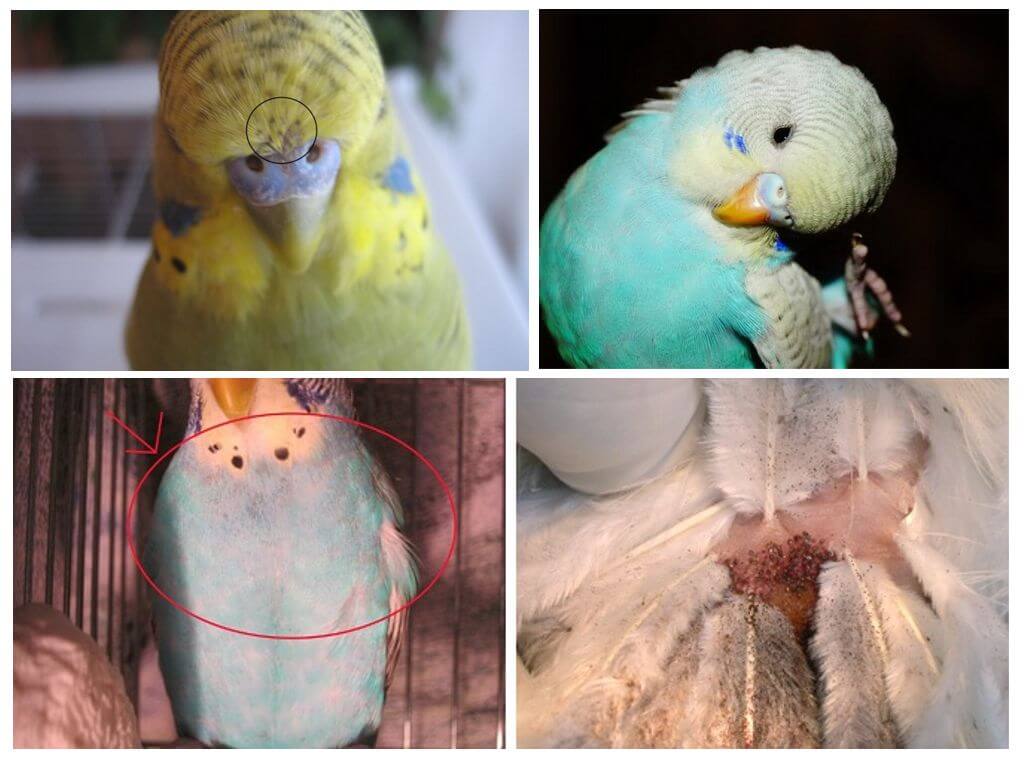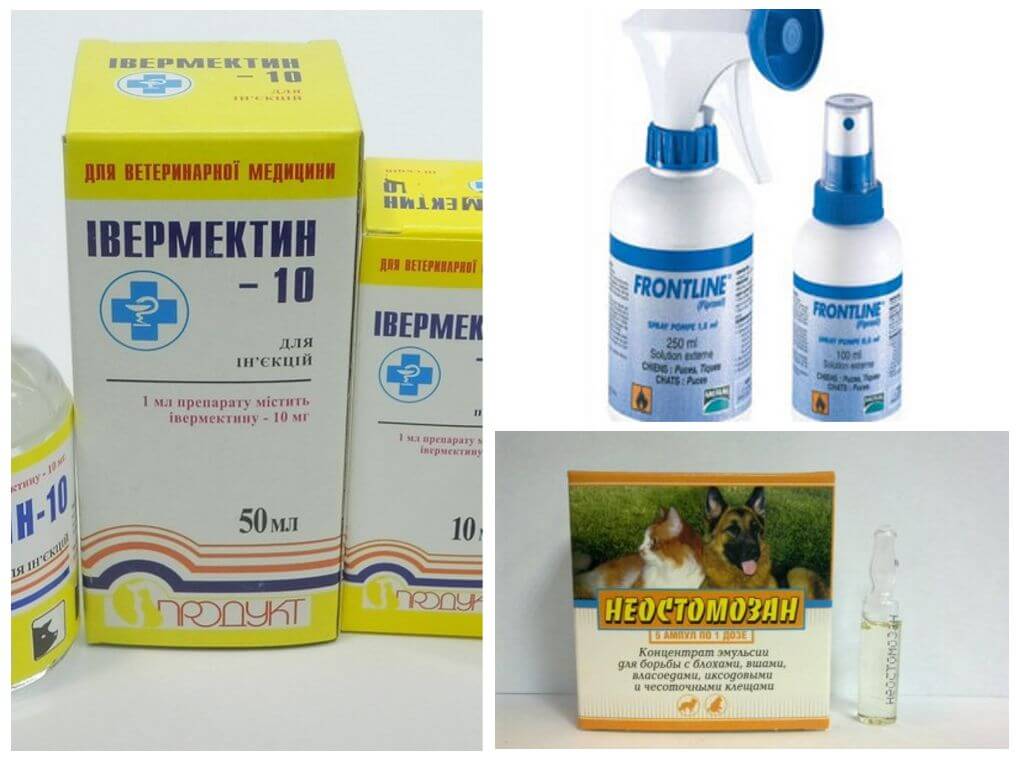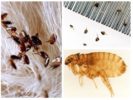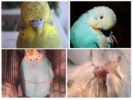- Fleas
- Parrot fleas
- Flea Remedies
Many people have the word fleas associated with tetrapods. And the fact that parasites are able to start in decorative birds may seem like a big surprise. Indeed, not everyone knows if a parrot can have fleas. However, bloodsuckers are able to live in all animals. Birds and especially budgies are no exception. A flea problem is a very rare occurrence. Therefore, it will not be out of place to know why bird fleas are started at a parrot, how to identify them and, therefore, how to get rid of them.
What do parasites look like?
Almost every owner of a feathered pet can face fleas at domestic parrots, causing them great discomfort. Bird flea in appearance and structure is very similar to a dog parasite. This is a very small (1 to 5 mm) insect that has a flat brown tint body. The pest has 3 pairs of legs, the hind legs are the longest, used for jumping. Below you can see how fleas in parrots look in the photo. The life span of the pest is only 2 weeks, however, during this period the insect manages to lay a large number of eggs.

Quite often parasites start in poultry (chickens, ducks, geese). They live mainly in bird nests. The most active pests mate and breed during the period when the bird hatches eggs and takes care of its offspring.
What are dangerous pests
Fleas living on the body of budgies do not parasitize humans. However bite a person or other pets can still. Important is the fact that bloodsuckers are able to tolerate various infectious diseases that pose a threat to the health of a feathered pet. In addition, bird fleas give the parrot great discomfort, which can result in depression, exhaustion and anemia. They are able to bring young chicks even to death.
Signs of the presence of insects in parrots
Fleas in parrots may not be detected immediately, due to the miniature size of insects and behavior. Typically, their presence is manifested by the following symptoms:
- the parrot constantly scratches itself and shakes off feathers;
- the feathered one has no appetite;
- the bird becomes restless and makes loud noises;
- the winged pet intensively loses its plumage and body weight.
The presence of these factors should be a signal to carefully examine the parrot, or visit a veterinarian.

Important!
Budgerigar fleas, unlike canine or cat fleasDo not cause irritation or redness on the skin. Therefore, parasites can only be detected when there are a lot of them, and only by visual inspection.
How fleas enter the house
In the house where they keep budgies, parasites can penetrate in various ways:
- through vents;
- from damp basements and attics where pigeons like to hide - they are the carriers of fleas in natural conditions;
- you can bring parasites into the house on clothes;
- infection of other pets.
Often you can buy a budgerigar already infected with fleas in the market, where several birds are kept in one enclosure.
Methods of struggle and means
The question of how to get fleas from a parrot at home is puzzled by all those who discovered parasites in their winged pet. Treatment of a bird from blood-sucking insects is a rather complicated process, and this is largely due to the fact that not everyone can fearlessly take a bird in their hands. After all, a parrot can pinch a very painful beak. And if fleas are found in the Corella, then there is a high probability of serious injury. To avoid this, it is better to treat birds with leather gloves.
Many people are afraid to simply harm the bird if they act improperly, because the parrot must not only be taken, but also held in hands. However, treatment of fleas in budgies is still necessary.
Treatment of a parrot from parasites involves three stages:
- poultry processing;
- cell treatment;
- prevention.
Derive a flea from a parrot
Before proceeding with the processing of a parrot, you must obtain confirmation from a veterinarian. Indeed, the characteristic signs of the presence of fleas can be caused by any infections or other pests. A self-established diagnosis may be incorrect, and the result of such treatment can only harm the pet.
You can get fleas from parrots using such means as:
- frontline;
- Iwamek.
The drugs are quite toxic and unsafe if swallowed. Therefore, they process only the skin of a bird; contact with feathers is unacceptable.

You can rid a parrot of fleas with the help of anti-cloud baths. Anostomazan is a safe means to combat parasites. The required dose of the drug specified in the instructions is dissolved in warm water. Then, the bird is dipped into the resulting solution for 7-10 seconds, holding its head. You can also use a spray bottle, and spray them with the whole body of a parrot. It is important to correctly calculate the dose, taking into account the weight and dimensions of the bird.
Cell processing
To prevent fleas from appearing in birds, it is mandatory to process not only the parrot, but also its cage. This issue should be given maximum attention and time. The cells are treated in the absence of a pet, after having previously removed all the usual toys and home decoration from it.
The cell must be thoroughly washed and dried, and then treated with special tools. Then it is carried out for 2-3 hours on a balcony or in another well-ventilated room. Then they wipe with a napkin and return to the "rightful owner". Water and food containers are also thoroughly washed and installed in the parrot's cage.
Prevention
To prevent the emergence and spread of bird fleas in the cage, you must follow these rules:
- Following the rules of hygiene will ensure a healthy lifestyle for your parrot. It should be periodically cleaned in the cage: change the litter, grass, food and water.
- The use of natural insecticides that will help rid a feathered home of blood-sucking insects. One such remedy is common wormwood - a grass that repels parasites. It is enough just to place its branches in the cage, and periodically replace them with fresh ones.
- Having decided to add a new neighbor to your pet, you need to keep the rookie in quarantine for some time. Insecticidal treatment will help save him from possible fleas. And only after that can a wave be allowed into the common cell.
- For preventive purposes, you can use the bath with ash, which will help prevent the attack of fleas to the birds.
Birds or animals in the house are, first of all, responsibility not only for their feeding, but also creation of favorable conditions for their living. Only then will your pet be attractive, playful and healthy.
Reviews
They bought a parrot, and began to notice that it very often itches. I had to see a doctor, the diagnosis was fleas.I was really surprised, because I did not know before that they also happen to birds. Processed by Front Line, everything went.
Marina, Kirovograd
I process my parrots regularly wormwood broth, and the cell anti-cloud agent.
Nina Petrovna, Moscow
The parrot often combed feathers, that even in some places bald patches appeared. They showed him to a veterinarian who discovered fleas in a bird. After which he gave us a powder, which needed to process places under the wings. After the first use, the parrot stopped itching.
Leon, Saratov






